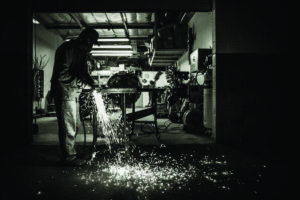
Prime Cut
When designing large sculptures a critical fabrication question is what method to use to cut accurate shapes in sheet/plate metal and other materials. The more complex the design is, the more critical accurate cutting becomes.
There are three state-of-the-art industrial cutting methods to choose from, waterjet, laser, and plasma torch. They are all done by machine using digital CAD files created in a 3D design program like Solidworks.
The following is a basic cutting methods primer for artists to help choose which method is right for your needs.
Plasma Cutting
Plasma cutting can be done with a handheld torch or mechanically controlled with a CAD machine cutter. Although I have cut steel for many years with a handheld plasma torch, it is more accurately done by machine.
A plasma cutting setup consists of a machine with a torch and a ground cable. It uses compressed air and electricity. Together these components create a super hot plasma arc that easily cuts through metal. Heat is an inevitable byproduct of plasma cutting, which can cause warping. It also generates fumes and smoke and requires proper ventilation to operate safely. Because it needs an electrical arc, this method can’t be used on non-conductive materials, like stone, wood, and plastic. It can only be used on both ferrous and nonferrous metals.
The benefits of plasma cutting are its relatively low cost, accessibility for a small shop, and fast cutting speed on thin material. The downside is potential warping, fumes, and cleaning a small amount of slag which is left on the cut edge.
Laser Cutting
Laser cutting is a super precise method of cutting metal and some non-metal materials. Cutting is fully automated and all shapes to be cut must be programmed into the machine with a dxf file. The laser cutter uses a nozzle, curved lens, and compressed gas to create a focused and spherical pinpoint of light that zips through metal. It creates fine detail and smooth edges.
The cost of a laser cutting machine is considerable and therefore an artist must subcontract out to a metal fabricator to make use of this cutting technology.
Waterjet Cutting
Unlike laser or plasma cutting that use a heat energy source, waterjet uses a high-pressure stream of water to cut materials. The jet of water is combined with an abrasive material, like garnet or aluminum oxide to create an incredibly efficient water knife. Of the three methods, waterjet cutting is the most precise with tolerances of up to 0.001″.
At its beginning, waterjet cutting was only used for thin and delicate materials, like paper. Now, due to advances in technology, waterjet can be used to cut almost any material, including metals, ceramic, stone, marble, and wood. It’s commonly used to produce parts for the aerospace industry, as well as ceramic and marble pieces for complex mosaic construction.
Again, because of the prohibitive cost of a waterjet cutting machine which includes three phase electric power and plumbing, it is beyond the scope of most moderate sized shops.


